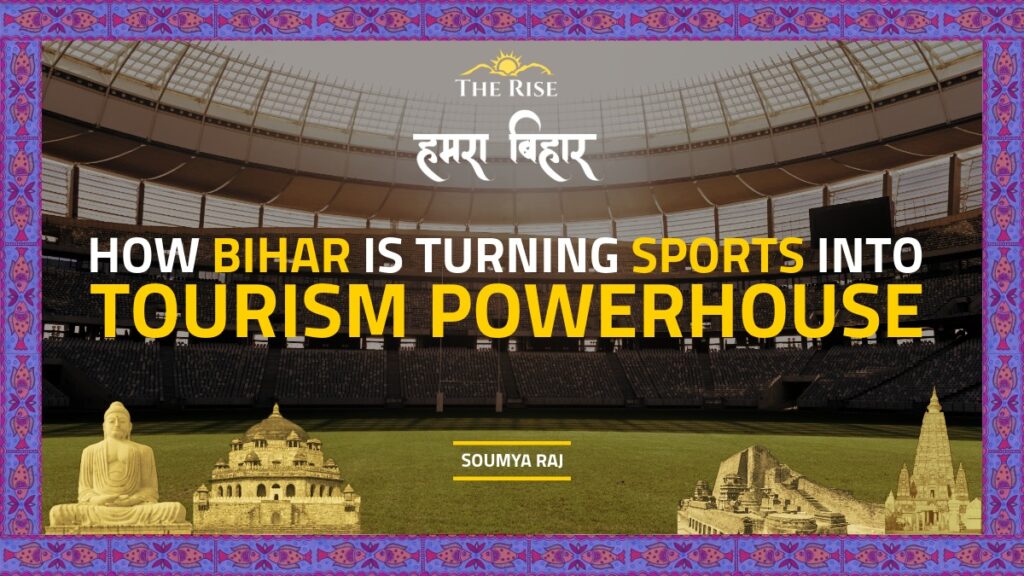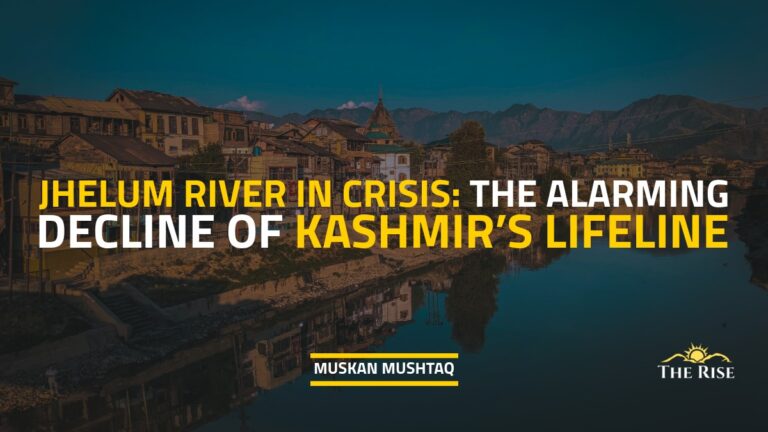Bihar’s sporting revolution is more than new stadiums and glossy inaugurations; it is an effort to reconfigure the state’s economy where sport becomes an engine of travel, investment, and local entrepreneurship.
Rajgir has just cut the ribbon on Bihar’s first world-class international cricket stadium — a 45,000-seat arena with gleaming pavilions and Olympic-grade facilities. But the real story lies beyond the boundary ropes. For a state long associated with Buddhist trails and ancient ruins, this colossus signals a shift: sport is now Bihar’s new tourism currency. Each new stadium, youth game, or international tournament doesn’t just showcase athletes; it draws in visitors, fills hotels, boosts airports, and gets the local economy moving.
In this new equation, cricket pitches and hockey turfs stand shoulder to shoulder with monasteries and stupas, building a sporting-tourism economy that could redefine Bihar’s image far beyond its borders. The government, keen to embed sports into the state’s identity, has rolled out schemes like Mashaal 2024, Medal Lao & Naukri Pao, thus pitching sports not just as recreation but as aspiration. [2]
Positioning Bihar as a stage for prestigious tournaments, the government of Bihar is betting on the magnetic pull of these mega-events — the crowds they draw, the revenue they spin, and the visibility they bring. The payoff is already visible in packed stadiums, surging hotel bookings, and new attention on the state’s cultural map, laying both immediate gains and the foundation for long-term tourism growth. [5]
Further, the commitment to sports infrastructure growth can be seen in the state’s financial dedication to sports, which has seen a significant increase — the sports budget rose to ₹568 crore for 2025–26, up from ₹480 crore the previous year [1]. This budget allocates ₹373 crore for stadiums and sports infrastructure, with an additional ₹195 crore reserved for sports development activities and athlete support programs. Major ongoing Sports Infrastructure Projects in Bihar:
| Project Name | Location | Investment | Key Features |
| Sports City | Punpun, Patna. | ₹574 crores | 100-acre complex, multi-sports stadiums, Olympic-level training centers. |
| International Cricket Stadium | Rajgir, Nalanda. | Parts of Sports Budget | International standards, BCCI-approved maintenance |
| Sports University | Rajgir, Nalanda. | Established | Specialized training and education for athletes |
| Block-Level Stadiums | 252 blocks across Bihar | ₹373 crore allocation | Grassroots sports infrastructure development |
The investment in these sports infrastructure represents a revolution aimed at encouraging youth participation to produce Olympic-level athletes by 2032. The state’s strategy includes decentralization of sports facilities to village and block levels, democratizing access to sports and creating more opportunities for community involvement and talent discovery.
The Nawada Kabaddi Revolution stands as a remarkable testament to Bihar’s sporting resurgence, where the state’s women’s kabaddi team advanced to the semi-finals of the Pro Kabaddi League. Similarly, Priti Kumari, once constrained by limited training facilities, found renewed opportunity through access to local coaching centres in Muzaffarpur. She represented India in an international junior archery tournament, securing accolades at the Asia Cup and the Khelo India Games. [9]
Further, the Sporting revolution is also visible in the mega-events that Bihar has hosted. The 7th edition of the Khelo India Youth Games (May 2025) was spread across five cities: Patna, Rajgir, Gaya, Bhagalpur, and Begusarai. This mega-event brought approximately 10,000 athletes, trainers, support staff, and technical personnel from all over India to Bihar, creating substantial demand for accommodation, food services, transportation, and tourist activities.[5] The ₹119 crore sanctioned for the event wasn’t just for sports—it created massive demand for hotels, restaurants, transport services, and sightseeing circuits.
Also Read: The New Guard and Old Barriers: An Analysis of the Socio-Economic Profile of Bihar’s Legislators
Similarly, the successful hosting of the Hero Asia Cup Hockey Tournament in Rajgir (Aug–Sep 2025) was a landmark for Bihar, boosted by private sponsors like Hero and HP Lubricants. This public-private partnership, formalized through an MoU with the Bihar State Sports Authority, demonstrated how corporate investment can elevate state infrastructure to international standards. The event not only turned the region into a global hub but also signalled growing investor confidence, positioning Bihar as an emerging destination for large-scale sports investment. [4]
More often than not, these mega events lead visitors to Bihar’s historical and spiritual landmarks: the Bodh Gaya temple complex, ruins of Nalanda, and Rajgir. In effect, sports tourism becomes a multiplier for heritage tourism. The tourism boost has created demand for new airports in Darbhanga, Purnea, and Gaya, as well as improved road connectivity. Thus, hosting of national/international matches draws visitors and puts Bihar on India’s sports tourism map.[2]
It can be highlighted that investing in sports infrastructure acts as a powerful economic multiplier, stimulating demand across various sectors such as hospitality, transportation, and construction, thereby boosting the state’s economy. For instance, Haryana’s establishment of 1,489 sports nurseries and 550 new sports department posts has nurtured talent and created jobs across the coaching industry, administration, and event management. Similarly, Punjab’s ₹1,194 crore investment in 3,100 stadiums has also created numerous employment opportunities. While sports contribute about 0.1% to India’s GDP, their state-level impact is significant, especially when linked to tourism and local economies. Haryana’s focus on sports has boosted its per capita income, showing that strategic investment in sports infrastructure enhances both athletic performance and economic growth. The result is a diversified local supply chain where tourism and sports intersect, widening the economic base. [6]
Although the plan seems ambitious, the transition from infrastructure creation to sustained tourism requires overcoming several challenges. First, connectivity: reliable intra-district transport and first/last-mile options must improve so visitors can travel between heritage sites and sports venues without friction. Second, hospitality capacity needs expansion — not just five-star hotels but budget options that cater to families and students need to be promoted in Bihar across regions. Third, destination marketing must change: Bihar’s tourism messaging needs to incorporate sports narratives alongside religious and heritage communications, targeting sports fans, school groups, and event organizers. Finally, maintaining community buy-in is crucial; local vendors and residents must see tangible benefits from hosting events and should have an active participation in the events. [2]
Bihar’s sporting revolution is more than new stadiums and glossy inaugurations; it is an effort to reconfigure the state’s economy where sport becomes an engine of travel, investment, and local entrepreneurship. The state must align infrastructure development with smart tourism strategies, stronger connectivity, and inclusive regional growth. If it succeeds, Bihar will not merely host matches — it will welcome visitors who stay longer, spend more, and explore its rich heritage. In the years ahead, these ambitious projects could evolve into a sustainable tourism ecosystem, firmly positioning Bihar on India’s sporting and cultural map.
Soumya Raj is a TRIP Intern under Hamra Bihar
Mentored and edited by Sneha Yadav.
REFERENCES
- Bihar Legislative Assembly. (2025). Budget speech 2025–26: Demand for grants for the Department of Youth, Art, and Culture. Government of Bihar.
- Department of Youth, Art, and Culture, Government of Bihar. (2024). Sports policy and infrastructure development report. Patna: Government of Bihar.
- Government of Bihar. (2025, May). Khelo India Youth Games 2025: Official report. Department of Sports.
- Hindustan Times. (2025, September 8). Hero Asia Cup Hockey 2025 concludes successfully in Rajgir. Hindustan Times.
- Indian Express. (2025, May 16). Khelo India Youth Games: Bihar welcomes over 10,000 athletes across five cities. The Indian Express.
- Ministry of Youth Affairs and Sports, Government of India. (2024). Khelo India annual report 2023–24. New Delhi: Government of India.
- Prasad, R. (2025, February 28). Bihar allocates ₹568 crore for sports in 2025–26 budget. The Times of India.
- Press Trust of India. (2025, April 15). Sports City Punpun project gets cabinet approval of ₹574 crore. PTI News Service.
- The Telegraph India. (2025, August 30). Rajgir gears up for Hero Asia Cup Hockey Tournament. The Telegraph.
- Tourism Department, Government of Bihar. (2024). Tourism circuits and development strategy: Ramayana, Buddhist, and sports circuits. Patna: Government of Bihar.












